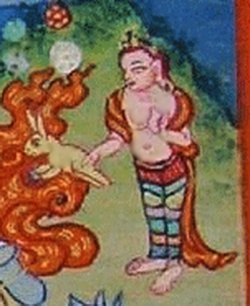Buddhist rituals
Buddhism is a path of transformation. This means that it is not enough to understand it intellectually. Following the Buddhist path means that we must engage the emotions and the imagination. To have that emotional engagement means having devotion or faith, and ritual is a way of directly engaging the emotions.
Buddhist rituals usually consist of three main elements: recitation, chanting and the making of offerings. The verses recited are usually associated with the principal tenets and ideals of Buddhism; and they give expression to the spiritual aspiration which makes someone a Buddhist. Buddhists usually chant in either Pali or Sanskrit (two ancient Indian languages) and chanting is a way of forging an emotional connection with Buddhist ideals. Sometimes Buddhists chant mantras, symbolic representations of Enlightenment in sound form. Offerings usually consist of flowers, symbolising both beauty and impermanence; candles, symbolising the radiance of Enlightenment; and incense which pervades the air in the same way that a life lived ethically touches the world.
Although there are different schools of Buddhism, throughout India, Japan, Tibet, China, and Southeast Asia, they all utilize a number of similar sacred rituals in the journey to self-enlightenment. Although meditation is typically one of the most well-known Buddhist rituals, mantras, mudras, prayer wheels, and pilgrimages are some of the otherritualistic practices incorporated by traditional Buddhists. Meditation is a way of mentally focusing or being mindful that is intended to help the practitioner achieve enlightenment. The variations between Buddhist schools of thought has produced different types of meditation, the two primary forms being samatha (tranquility) and vipassana (insight). The two types may be used either separately or together.
A mantra, a Sanskrit word which means “that which protects the mind,” is a sacred sound that is believed to invoke deities, garner supernatural protection and generate personal power. Tibetan Buddhism is focused more on mantras than most other types of Buddhism, and mantras are often chanted during meditation practice. A well-known Tibetan Buddhism mantra is “Om mani padme hum,” which is intended to invoke the deity Avalokiteshvara, and translates roughly to “Praise to the Jewel in the Lotus.” Mantras may be chanted privately or in large groups, depending on the strength of protection desired.
Less commonly known than mantras, mudras are a Buddhist ritual that involves the use of symbolic hand gestures in order to evoke specific ideas, Buddhas, deities, or scenes. They may be used in practice or be depicted in artistic renderings, and are intended to aid in Buddhist meditation. The five main esoteric mudras found in Buddhist art depict the five Dhyani Buddhas.
Mostly used by Tibetan and Nepalese Buddhists, prayer wheels are another aspect to Buddhist ritual. Prayer wheels are hollow cylinders, inside which are placed scrolls of mantras, that are mounted on rods and spun by Buddhists in lieu of chanting the mantras out loud. Oftentimes, prayer wheels may also represent the Wheel of the Law (Dharma) that Buddha set in motion. Prayer wheels are especially popular among devotees on pilgrimage.
Buddhist pilgrimage is a ritual of great significance. The most important destinations for Buddhist pilgrims are in Northern India and Southern Nepal’s Gangetic plains, between New Delhi and Rajgir, where Gautama Buddha lived and taught. The four main sites of pilgrimage are Lumbini (Buddha’s birthplace), Bodh Gaya (Buddha’s place of enlightenment), Sarnath (where Buddha first preached), and Kusinagara (where Buddha achieved Parinirvana).
